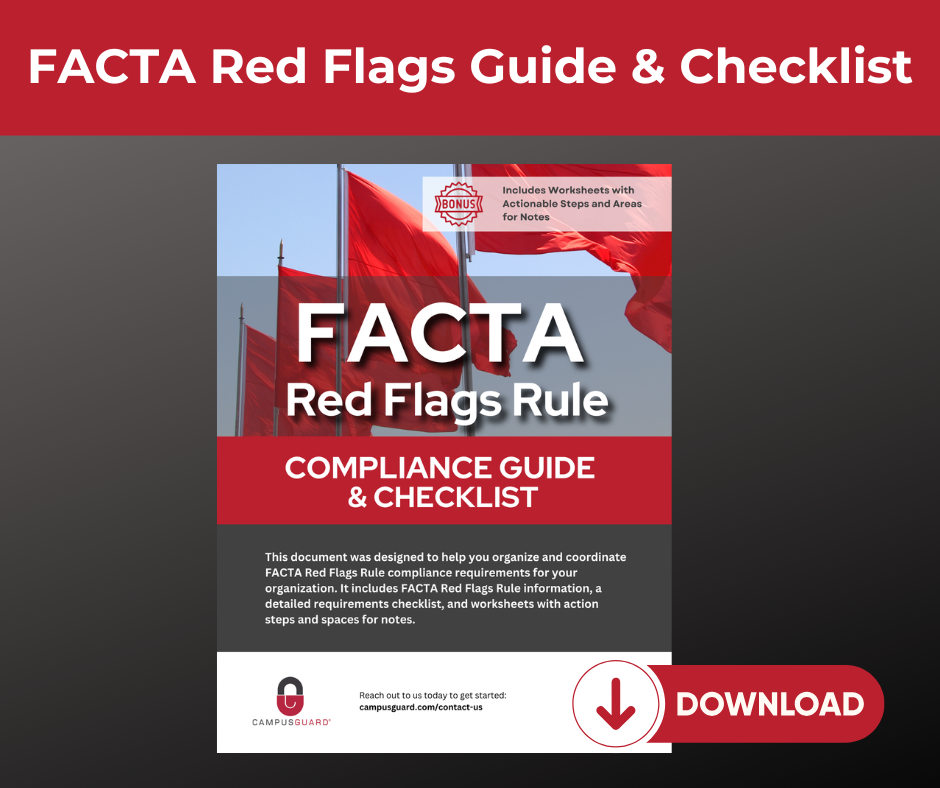FACTA Red FlagsFair and Accurate Credit Transaction Act
CampusGuard’s Red Flags Assessment with help your organization identify any gaps in compliance and prevent the costly consequences of identity theft.

Identify and Respond to Red Flags
The Red Flags Rule is intended to prevent identity theft and, in order to comply, organizations are required to implement an Identity Theft Prevention Program and provide “Red Flag” training to all employees who handle consumer data.
The Red Flags Rule applies to traditional financial institution-type companies (e.g., banks, credit unions, mortgage companies, etc.), and also “non-financial” entities that offer deferred payment solutions, which includes most campus-based organizations.
If your organization allows for deferred payment loans or for services rendered, you likely qualify as a “non-financial” entity and are subject to the Red Flags Rule.
Reasons to Build a Strong Identity Theft Prevention Plan
The Five Categories of Red Flags
These are the five warning signs defined by the FTC that can help you identify potential identity theft:
-
Alerts, notifications, or other warnings received from consumer reporting agencies or service providers, such as fraud detection services
-
The presentation of suspicious documents
-
The presentation of suspicious personal identifying information, such as a suspicious address change
-
The unusual use of, or other suspicious activity related to, a covered account
-
Notice from customers, victims of identity theft, law enforcement authorities, or other persons regarding possible identity theft in connection with covered accounts held by the financial institution or creditor
FACTA Red Flags Online Training Course
This course provides employees with the tools to help proactively prevent identity theft by identifying, detecting, and responding appropriately to potential red flags. Course reviews common risks and threats to covered accounts and how specific departments within your campus are impacted.
Modules for our FACTA Red Flags online training course include:
- FACTA Red Flags Overview
- Identifying and Responding to Red Flags
Download the FACTA Red Flags Rule Guide & Checklist
Our comprehensive guide includes:
- FACTA Red Flags Rule overview and requirements
- Identity Theft Prevention Program requirements
- The five categories of Red Flags
- Detailed FACTA Requirements Checklist and Worksheets with actionable steps and space for notes
- Additional FACTA resources

Why Choose CampusGuard?
The experts at CampusGuard provide strategic advice on regulatory applicability, questions of program implementation, assistance in the application of specific security documentation, and assessments and validation of implemented security controls to ensure appropriate protections are in place.
Average monthly cases of identity theft in 2023*
Average monthly cases of fraud in 2023*
Average monthly loss due to fraud in 2023*
Related Products and Services
Your Partner in Developing an Identity Theft Prevention Program
Creating your Identity Theft Prevention Plan can be an overwhelming process. The team at CampusGuard is ready to assist by assessing your needs, offering you guidance on remediation of compliance gaps, and training your employees on the FACTA Red Flags Rule.
Top FACTA Red Flags Frequently Asked Questions
The FACTA Red Flags Rule is a regulation under the Fair and Accurate Credit Transactions Act (FACTA) that requires certain businesses and organizations to implement a written Identity Theft Prevention Program to detect and respond to "red flags" or warning signs of identity theft.
The Red Flags Rule requires covered businesses and organizations to develop and implement a written Identity Theft Prevention Program that identifies and responds to "red flags" that signal possible identity theft. Red flags can include suspicious patterns or practices, such as unusual account activity, suspicious personal identification information, and alerts or warnings from credit reporting agencies.
The Identity Theft Prevention Program must include procedures for detecting, preventing, and mitigating identity theft, as well as guidelines for responding to detected red flags. The program must also be updated periodically to reflect changes in risks and new red flags that may emerge.
The Red Flags Rule applies to financial institutions and creditors that offer or maintain certain types of accounts, such as credit card accounts, and that have covered accounts that pose a risk of identity theft.
Failure to comply with the Red Flags Rule can result in penalties and fines as well as damage to a business's reputation and loss of customer trust.
To avoid penalties and other negative consequences, organizations subject to the Red Flags Rule should take steps to comply with the regulation, including developing and implementing an Identity Theft Prevention Program that meets the requirements of the rule, training employees on the program, and regularly reviewing and updating the program to reflect new risks and red flags.
Identity Theft in the Digital Age: Emerging Trends and Risks
Identity theft tactics evolve to keep up with the latest trends & technology. Here is our list of the most common identity theft methods.
Explore Common Identity Theft Tactics about the Identity Theft in the Digital Age: Emerging Trends and Risks

